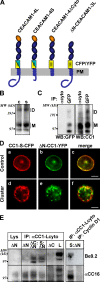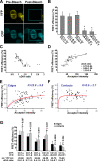Homophilic adhesion and CEACAM1-S regulate dimerization of CEACAM1-L and recruitment of SHP-2 and c-Src
- PMID: 19948503
- PMCID: PMC2779222
- DOI: 10.1083/jcb.200904150
Homophilic adhesion and CEACAM1-S regulate dimerization of CEACAM1-L and recruitment of SHP-2 and c-Src
Abstract
Carcinoembryonic antigen (CEA)-related cell adhesion molecule 1 (CAM1 [CEACAM1]) mediates homophilic cell adhesion and regulates signaling. Although there is evidence that CEACAM1 binds and activates SHP-1, SHP-2, and c-Src, knowledge about the mechanism of transmembrane signaling is lacking. To analyze the regulation of SHP-1/SHP-2/c-Src binding, we expressed various CFP/YFP-tagged CEACAM1 isoforms in epithelial cells. The supramolecular organization of CEACAM1 was examined by cross-linking, coclustering, coimmunoprecipitation, and fluorescence resonance energy transfer. SHP-1/SHP-2/c-Src binding was monitored by coimmunoprecipitation and phosphotyrosine-induced recruitment to CEACAM1-L in cellular monolayers. We find that trans-homophilic CEACAM1 binding induces cis-dimerization by an allosteric mechanism transmitted by the N-terminal immunoglobulin-like domain. The balance of SHP-2 and c-Src binding is dependent on the monomer/dimer equilibrium of CEACAM1-L and is regulated by trans-binding, whereas SHP-1 does not bind under physiological conditions. CEACAM1-L homodimer formation is reduced by coexpression of CEACAM1-S and modulated by antibody ligation. These data suggest that transmembrane signaling by CEACAM1 operates by alteration of the monomer/dimer equilibrium, which leads to changes in the SHP-2/c-Src-binding ratio.
Figures








Similar articles
-
Inside-out signaling promotes dynamic changes in the carcinoembryonic antigen-related cellular adhesion molecule 1 (CEACAM1) oligomeric state to control its cell adhesion properties.J Biol Chem. 2013 Oct 11;288(41):29654-69. doi: 10.1074/jbc.M113.504639. Epub 2013 Sep 4. J Biol Chem. 2013. PMID: 24005674 Free PMC article.
-
CEACAM1 long isoform has opposite effects on the growth of human mastocytosis and medullary thyroid carcinoma cells.Cancer Med. 2017 Apr;6(4):845-856. doi: 10.1002/cam4.1050. Epub 2017 Mar 23. Cancer Med. 2017. PMID: 28332308 Free PMC article.
-
The CEACAM1 N-terminal Ig domain mediates cis- and trans-binding and is essential for allosteric rearrangements of CEACAM1 microclusters.J Cell Biol. 2009 Nov 16;187(4):553-67. doi: 10.1083/jcb.200904149. J Cell Biol. 2009. PMID: 19948502 Free PMC article.
-
Mechanism and function of CEACAM1 splice isoforms.Eur J Clin Invest. 2024 Dec;54 Suppl 2(Suppl 2):e14350. doi: 10.1111/eci.14350. Eur J Clin Invest. 2024. PMID: 39674874 Free PMC article. Review.
-
[CEACAM1--a less well-known member of the family of carcinoembryonic antigens].Cas Lek Cesk. 2003;142(5):259-63. Cas Lek Cesk. 2003. PMID: 12920788 Review. Czech.
Cited by
-
Disturbed expression of splicing factors in renal cancer affects alternative splicing of apoptosis regulators, oncogenes, and tumor suppressors.PLoS One. 2010 Oct 27;5(10):e13690. doi: 10.1371/journal.pone.0013690. PLoS One. 2010. PMID: 21082031 Free PMC article.
-
Cross Talk in HEK293 Cells Between Nrf2, HIF, and NF-κB Activities upon Challenges with Redox Therapeutics Characterized with Single-Cell Resolution.Antioxid Redox Signal. 2017 Feb 20;26(6):229-246. doi: 10.1089/ars.2015.6419. Epub 2015 Nov 11. Antioxid Redox Signal. 2017. PMID: 26415122 Free PMC article.
-
Inside-out signaling promotes dynamic changes in the carcinoembryonic antigen-related cellular adhesion molecule 1 (CEACAM1) oligomeric state to control its cell adhesion properties.J Biol Chem. 2013 Oct 11;288(41):29654-69. doi: 10.1074/jbc.M113.504639. Epub 2013 Sep 4. J Biol Chem. 2013. PMID: 24005674 Free PMC article.
-
CEACAM1 long isoform has opposite effects on the growth of human mastocytosis and medullary thyroid carcinoma cells.Cancer Med. 2017 Apr;6(4):845-856. doi: 10.1002/cam4.1050. Epub 2017 Mar 23. Cancer Med. 2017. PMID: 28332308 Free PMC article.
-
Carcinoembryonic Antigen Cell Adhesion Molecule 1 long isoform modulates malignancy of poorly differentiated colon cancer cells.Gut. 2016 May;65(5):821-9. doi: 10.1136/gutjnl-2014-308781. Epub 2015 Feb 9. Gut. 2016. PMID: 25666195 Free PMC article.
References
-
- Becker A., Neumeier R., Heidrich C., Loch N., Hartel S., Reutter W. 1986. Cell surface glycoproteins of hepatocytes and hepatoma cells identified by monoclonal antibodies. Biol. Chem. Hoppe Seyler. 367:681–688 - PubMed
-
- Brümmer J., Neumaier M., Göpfert C., Wagener C. 1995. Association of pp60c-src with biliary glycoprotein (CD66a), an adhesion molecule of the carcinoembryonic antigen family downregulated in colorectal carcinomas. Oncogene. 11:1649–1655 - PubMed
Publication types
MeSH terms
Substances
LinkOut - more resources
Full Text Sources
Other Literature Sources
Molecular Biology Databases
Miscellaneous

